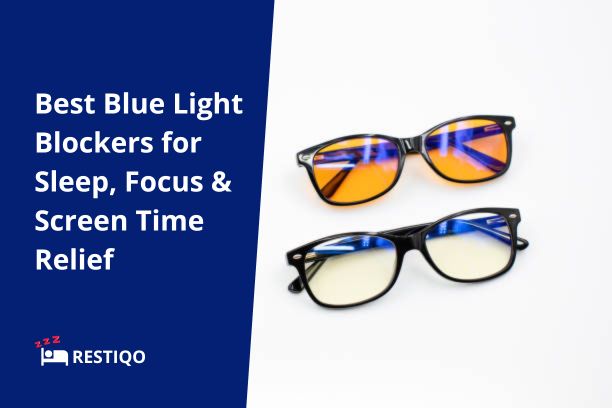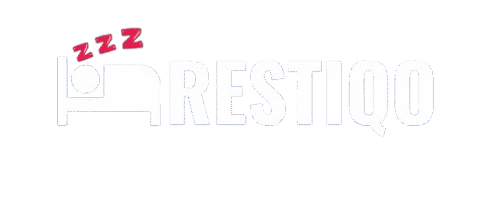
If your eyes feel fried, your sleep sucks, and your focus disappears halfway through the workday, here’s your likely villain: blue light overexposure.
The fix isn’t quitting screens altogether (we’re not Amish). The real solution is smart protection — blue light blockers that actually work. But with all the noise out there — cheap knockoffs, useless filters, and overpriced “biohacker” gear — it’s hard to know what’s legit.
This guide cuts through the hype and shows you the best blue light blockers for every situation:
- Glasses for sleep and all-day comfort
- Apps and filters for phones, tablets, and computers
- Kid-safe options that won’t cause tantrums
- Product rankings based on form, fit, price, science, and real-user feedback
What Are Blue Light Blockers?
Blue light blockers are tools — glasses, filters, or apps — that reduce your exposure to artificial blue light from screens, LEDs, and digital devices.
Blue light isn’t evil. During the day, it helps regulate your circadian rhythm and keeps you alert. But too much of it — especially at night — throws your sleep cycle into chaos and fries your eyes in the process.
There are three main types of blue light blockers:
- 👓 Glasses: Tinted or clear-lens eyewear that blocks or filters specific light wavelengths
- 📱 Screen Filters: Physical or digital overlays for phones, tablets, monitors, or TVs
- 💡 Apps & Software: Tools that adjust your screen’s color temperature in real-time
TL;DR: Blue light blockers are like sunglasses for your digital life — protecting your eyes, focus, and sleep from constant exposure.
Do Blue Light Blockers Really Work?
Yes, but only when used correctly, and with the right type for your needs.
Not all blue light blockers are created equal. Some are cosmetic gimmicks. Others are backed by real data showing improved sleep latency, reduced digital eye strain, and even better cognitive performance after extended screen time.
What They Help With:
- 😴 Sleep improvement: By reducing melatonin suppression at night
- 👀 Eye strain relief: Less dryness, less squinting, fewer headaches
- 🧠 Focus and energy: Especially during long work or gaming sessions
- 📉 Blue light exposure: Especially critical for night-shift workers or anyone glued to screens after 6 PM
What They Don’t Do:
- Cure insomnia on their own
- Replace good sleep hygiene
- Work instantly—some benefits build over 7–10 days of use
“Blue light exposure in the evening suppresses melatonin and shifts circadian rhythm.” — NIH Study
“Digital eye strain is a real, measurable condition. Blue light is just one piece of that puzzle.” — American Academy of Ophthalmology
Best Blue Light Blockers (Ranked by Category)
We’ve reviewed and tested dozens of products. Below are the best blue light blockers ranked by specific needs—sleep, focus, gaming, and all-day wear.
Best Overall Blue Light Glasses
Felix Gray Sleep Glasses
- Lens Type: Amber-tinted
- Blue Light Blocked: ~98% of wavelengths under 455nm
- Ideal For: Nighttime use, sleep optimization
- Certifications: FDA-registered, lab-tested
Pros:
- Clinically backed lens design
- Great build quality and stylish frame options
- Reduces sleep latency and improves morning alertness
Cons:
- On the pricier side (~$95+)
- May be too warm-colored for daytime use
“I sleep deeper and feel more clearheaded every morning since using these nightly.” – Verified user
Best Blue Light Glasses for Sleep
Swanwick Sleep Swannies Night Glasses
- Lens Type: Deep amber
- Blue Light Blocked: 99% of high-energy visible light
- Ideal For: Wearing 2 hours before bed
Pros:
- Maximum nighttime protection
- Blocks melatonin-disrupting wavelengths
- Lightweight and durable
Cons:
- Not ideal for color-sensitive tasks
- More functional than fashionable
Best for Gaming or Productivity
GUNNAR Intercept Blue Light Glasses
- Lens Type: Yellow-tinted
- Blue Light Blocked: ~65%
- Ideal For: Gamers, coders, digital creatives
Pros:
- Patented lens tech reduces glare and enhances contrast
- Comfortable for long wear (lightweight frame)
- Slight magnification improves focus
Cons:
- May distort color slightly for video/photo work
- Less effective at night than amber lenses
Best Blue Light Apps & Screen Filters
App: f.lux (Windows, Mac, Linux)
App: Night Shift (iOS/Mac), Night Light (Windows)
Screen Filter: Ocushield Anti-Blue Light Screen Protector
Pros:
- Free or low-cost
- Auto-adjusts to time of day
- Great for those who hate wearing glasses
Cons:
- Doesn’t block light emitted from surroundings
- Software-only filters can’t stop direct eye exposure
Best for Kids or Teens
Pixel Eyewear Kids Collection
- Lens Type: Clear or slightly tinted
- Blue Light Blocked: 50–60%
- Best For: Homework, online learning, safe screen exposure
Pros:
- Durable and kid-friendly designs
- Lightweight and adjustable fit
- Prescription and non-prescription options
Cons:
- Not strong enough for deep nighttime sleep support
Blue Light Blocker Comparison Table
| Product Name | Type | Blue Light Blocked | Ideal Use Case | Price Range |
| Felix Gray Sleep Glasses | Glasses | ~98% | Sleep optimization | $$$ |
| Swanwick Swannies | Glasses | ~99% | Nighttime only | $$ |
| GUNNAR Intercept | Glasses | ~65% | Gaming & productivity | $$ |
| f.lux / Night Shift | App | Varies | General screen usage | Free |
| Ocushield Screen Filter | Filter | ~90% | Phone/laptop filters | $–$$ |
| Pixel Eyewear (Kids) | Glasses | 50–60% | Kids’ daily use | $$ |
How to Choose the Right Blue Light Blocker
Your ideal blue light blocker depends on when you use screens, why you’re using them, and what symptoms you want to fix.
Don’t just grab the cheapest pair off Amazon and expect miracles. The blocker that works for a gamer at 11 PM won’t necessarily help a remote worker trying to focus mid-morning or a kid doing homework on a tablet.
Here’s how to choose the right one for your specific use case:
👓 If You Struggle with Sleep
- Choose: Deep amber or red-tinted glasses
- Look for: High blue light filtering (~95%+), especially wavelengths under 455nm
- When to use: 1.5–2 hours before bed
- Top Pick: Swanwick Swannies
🎯 If You Need Focus During Daytime Work
- Choose: Clear or pale-yellow lenses
- Look for: Anti-glare coating + ~30–65% blue light filtering
- When to use: 9–5 or during screen-intensive tasks
- Top Pick: GUNNAR Intercept
🎮 If You Game or Use Screens at Night
- Choose: Yellow-tinted glasses or screen filters
- Look for: Glare reduction, contrast enhancement, high blue light filtering
- When to use: Evening or nighttime sessions
- Top Pick: GUNNAR + Ocushield combo
👶 If You’re Buying for Kids
- Choose: Lightweight, durable glasses with flexible frames
- Look for: Scratch resistance, soft frame ends, 40–60% filtering
- When to use: Homework, tablet use, YouTube sessions
- Top Pick: Pixel Eyewear Kids Line
🧠 If You Hate Glasses
- Choose: App + screen protector combo
- Look for: Software like f.lux or Night Shift, paired with a physical filter
- Top Pick: f.lux + Ocushield
Bonus Tip: Always check for FDA registration, CE certification, or third-party lab testing — these separates legit products from gimmicks.
When & How to Use Blue Light Blockers
Timing is everything especially when it comes to your sleep and circadian rhythm.
When to Use Them:
| Time of Day | Use Case | Recommended Blocker |
| Morning | Light screen work | Clear lenses or low-filter glasses |
| Afternoon | Work sessions, gaming | Yellow lenses or screen filters |
| Evening | Wind-down, late work sessions | Amber/red-tinted glasses |
| Night | 2 hours before bed | Deep amber lenses or zero-screen time |
How to Use Them (Best Practices):
- Wear consistently: One-off use doesn’t cut it. Benefits stack with daily use.
- Clean lenses regularly: Dirt reduces clarity and increases eye strain.
- Don’t mix with bright overhead lighting at night: It cancels the benefit.
- Pair with good sleep hygiene: Blockers help, but won’t undo caffeine at 9 PM.
Avoid These Rookie Mistakes:
- Buying clear lens “fashion” blockers that don’t list nanometer ratings
- Wearing daytime glasses at night (they don’t block melatonin disruptors)
- Leaving brightness at max and thinking you’re protected
- Skipping blue light mode on your phone or laptop—layering works best
Blue Light Blocker Myths Debunked
Let’s bust some of the dumb claims floating around the wellness world.
❌ “Blue Light Glasses Cure Insomnia”
Nope. They support better sleep by reducing melatonin suppression but they can’t override stress, bad routines, or that espresso you slammed at 8 PM.
❌ “The Darker the Tint, the Better”
Not always. Darker isn’t smarter unless you’re using the glasses specifically for nighttime melatonin protection. Over-filtering during the day can actually hinder focus and lead to dull, low-energy vision.
❌ “If You Use Filters, You Don’t Need Glasses”
That’s like saying sunscreen makes shade useless. Filters reduce emission from screens, but your eyes are still exposed to overhead LED lights and ambient sources unless covered by lenses.
❌ “They’re Just a Trend — No Real Science”
False. Peer-reviewed studies from the NIH, Sleep Foundation, and AAO all confirm that high-frequency blue light disrupts sleep patterns, reduces melatonin, and contributes to digital eye strain.
“Users wearing blue light-blocking lenses 2 hours before bed showed significantly improved sleep quality.” – Sleep Foundation Study
Final Buying Guide Summary
Still unsure what to grab? Here’s your down-to-earth checklist.
Quick Checklist for Picking the Right Blocker:
- Want better sleep? Get amber/red-tinted glasses rated for nighttime
- Need all-day screen relief? Choose anti-glare clear or pale yellow lenses
- Work late or game often? Go for Gunnar + f.lux combo
- Buying for kids? Get certified, scratch-resistant, flexible-frame glasses
- Hate glasses? Combine screen filters with Night Shift or f.lux
Wrapping Up
You’ve now got a no-fluff breakdown of the best blue light blockers for sleep, focus, and screen relief — plus how to pick, use, and benefit from them properly.
Here’s what to do next:
- 👓 If sleep is your main issue — go with amber-tinted glasses.
- 🧠 If you want to focus better during the day — clear/yellow lenses + filters work best.
- 💡 If you hate glasses — apps + screen protectors can help, but don’t go solo.
- 👨👩👧👦 If you’re shopping for kids — prioritize fit, safety, and light-medium tinting.
Ready to block the glare, reclaim your nights, and focus like a boss? Compare the best blue light blockers now and choose your perfect match.
Frequently Asked Questions (FAQ)
What are the best blue light glasses for sleep?
The best blue light glasses for sleep are amber or red-tinted lenses that block over 95% of high-energy visible (HEV) blue light, especially below 455nm.
Top options include Felix Gray Sleep Glasses and Swanwick Swannies, both of which are lab-tested and designed for nighttime use. They help reduce melatonin suppression and improve sleep latency when worn 1–2 hours before bed.
Can blue light blockers improve focus during screen time?
Yes, blue light blockers can enhance focus by reducing eye strain, screen fatigue, and glare especially during long work or gaming sessions.
Clear or pale yellow-tinted glasses like those from GUNNAR or Pixel Eyewear are ideal for improving visual comfort and mental clarity without distorting screen colors.
Do blue light apps work as well as glasses?
No, not completely. Apps like f.lux and Night Shift reduce screen-emitted blue light, but they don’t protect you from ambient light sources or offer physical lens filtration.
For best results, use apps with glasses or filters for multi-layered protection, especially in the evening.
Is there a difference between day and night blue light blockers?
Yes, daytime blockers often have clear or yellow lenses to reduce glare and screen fatigue, while nighttime blockers use amber or red tints to filter melatonin-disrupting wavelengths.
Using night-tinted glasses during the day may affect color perception and energy levels, while clear lenses won’t block enough blue light at night.
How long before bed should I wear blue light glasses?
Wear blue light glasses at least 1.5 to 2 hours before bedtime to minimize melatonin suppression and support a healthy sleep cycle.
This allows your circadian rhythm to naturally trigger the sleep hormone cascade and reduces the risk of delayed sleep onset.

